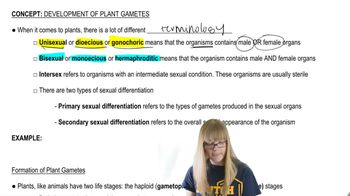Microsatellites are currently exploited as markers for paternity testing. A sample paternity test is shown in the following table in which ten microsatellite markers were used to test samples from a mother, her child, and an alleged father. The name of the microsatellite locus is given in the left-hand column, and the genotype of each individual is recorded as the number of repeats he or she carries at that locus. For example, at locus D9S302, the mother carries 30 repeats on one of her chromosomes and 31 on the other. In cases where an individual carries the same number of repeats on both chromosomes, only a single number is recorded. (Some of the numbers are followed by a decimal point, for example, 20.2, to indicate a partial repeat in addition to the complete repeats.) Assuming that these markers are inherited in a simple Mendelian fashion, can the alleged father be excluded as the source of the sperm that produced the child? Why or why not? Explain.
Table of contents
- 1. Introduction to Genetics51m
- 2. Mendel's Laws of Inheritance3h 37m
- 3. Extensions to Mendelian Inheritance2h 41m
- 4. Genetic Mapping and Linkage2h 28m
- 5. Genetics of Bacteria and Viruses1h 21m
- 6. Chromosomal Variation1h 48m
- 7. DNA and Chromosome Structure56m
- 8. DNA Replication1h 10m
- 9. Mitosis and Meiosis1h 34m
- 10. Transcription1h 0m
- 11. Translation58m
- 12. Gene Regulation in Prokaryotes1h 19m
- 13. Gene Regulation in Eukaryotes44m
- 14. Genetic Control of Development44m
- 15. Genomes and Genomics1h 50m
- 16. Transposable Elements47m
- 17. Mutation, Repair, and Recombination1h 6m
- 18. Molecular Genetic Tools19m
- 19. Cancer Genetics29m
- 20. Quantitative Genetics1h 26m
- 21. Population Genetics50m
- 22. Evolutionary Genetics29m
18. Molecular Genetic Tools
Genetic Cloning
Problem 29
Textbook Question
Vitamin E is the name for a set of chemically related tocopherols, which are lipid-soluble compounds with antioxidant properties. Such antioxidants protect cells against the effects of free radicals created as by-products of energy metabolism in the mitochondrion. Different tocopherols have different biological activities due to differences in their retention by binding to gut proteins during digestion. The one retained at the highest level is α-tocopherol, whereas γ-tocopherol is retained at less than 10% of that efficiency. In Arabidopsis, α-tocopherol is the most abundant tocopherol in leaves, whereas γ-tocopherol is the most abundant in seeds. An enzyme encoded by the VTE4 gene can convert γ-tocopherol to α-tocopherol. How would you create an Arabidopsis plant that produces high levels of α-tocopherol in the seeds?
 Verified step by step guidance
Verified step by step guidance1
Identify the role of the VTE4 gene in tocopherol conversion: The VTE4 gene encodes an enzyme that converts γ-tocopherol to α-tocopherol. This is a key step in determining the levels of α-tocopherol in different tissues of Arabidopsis.
Determine the expression pattern of the VTE4 gene: In wild-type Arabidopsis, the VTE4 gene may not be highly expressed in seeds, which is why γ-tocopherol is more abundant in seeds compared to α-tocopherol.
Design a genetic modification strategy: To increase α-tocopherol levels in seeds, you could use a seed-specific promoter to drive the expression of the VTE4 gene. A seed-specific promoter ensures that the gene is expressed only in the seeds, where the conversion of γ-tocopherol to α-tocopherol is desired.
Introduce the modified VTE4 gene into Arabidopsis: Use a genetic transformation method, such as Agrobacterium-mediated transformation, to insert the VTE4 gene under the control of the seed-specific promoter into the Arabidopsis genome.
Verify and analyze the results: Grow the transformed plants and analyze the tocopherol content in the seeds using techniques like high-performance liquid chromatography (HPLC) to confirm that α-tocopherol levels have increased significantly compared to wild-type plants.
 Verified video answer for a similar problem:
Verified video answer for a similar problem:This video solution was recommended by our tutors as helpful for the problem above
Video duration:
3mPlay a video:
Was this helpful?
Key Concepts
Here are the essential concepts you must grasp in order to answer the question correctly.
Tocopherols and Their Functions
Tocopherols are a group of fat-soluble compounds, primarily known for their role as antioxidants. They protect cells from oxidative damage caused by free radicals, which are by-products of cellular metabolism. The most studied tocopherol, α-tocopherol, is particularly effective in this role and is retained more efficiently in the body compared to other forms like γ-tocopherol.
Recommended video:
Guided course

Functional Genomics
Genetic Engineering in Plants
Genetic engineering involves modifying an organism's DNA to achieve desired traits, such as increased nutrient production. In the context of Arabidopsis, techniques like CRISPR or transgenic approaches can be used to enhance the expression of specific genes, such as the VTE4 gene, which converts γ-tocopherol to α-tocopherol, thereby increasing α-tocopherol levels in seeds.
Recommended video:
Guided course

Plant Gamete Terminology
Gene Expression Regulation
Gene expression regulation is the process by which cells control the amount and timing of protein production. In plants, this can involve various mechanisms, including promoter selection and transcription factor binding. Understanding how to manipulate these regulatory elements can help in designing Arabidopsis plants that produce higher levels of α-tocopherol by ensuring that the VTE4 gene is expressed more effectively in seeds.
Recommended video:
Guided course

Penetrance and Expressivity
Related Videos
Related Practice
Textbook Question
870
views


